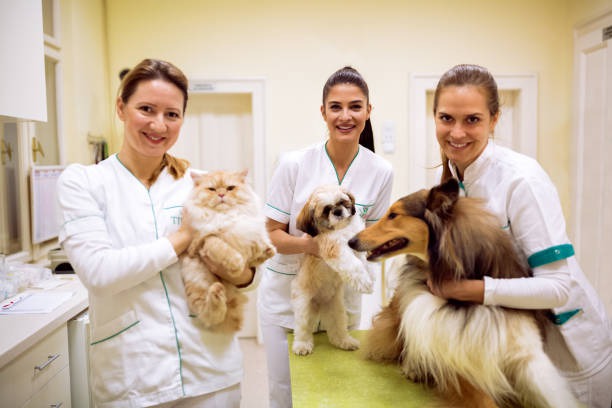What Can Pet Owners Expect During a Diagnostic Lab Visit?

As a pet owner, you naturally want to ensure your furry friend is in the best health possible. One critical aspect of maintaining your pet’s well-being is regular diagnostic lab visits. These visits play a significant role in detecting early signs of health issues, preventing serious illnesses, and keeping your pet in top shape.
What to Expect During the Visit
Diagnostic lab visits can sometimes be lengthy, so it’s essential to prepare for a bit of a wait. Here’s what typically happens:
Reception and Check-In: The front desk staff will greet you, check you in and ensure that all necessary paperwork is completed.
Physical Examination: A vet tech or veterinarian will perform a basic physical exam to gather more information about your pet’s health.
Sample Collection: Depending on the required tests, the vet team will collect blood, urine, fecal, or tissue samples.
Testing: These samples are sent to the lab, where they are analyzed. Depending on the complexity of the tests, this process may take some time.
Results and Consultation: Once the results are back, the vet will discuss them with you and outline any necessary treatments or follow-up care.
Preliminary Consultation
When you walk into the vet’s office for a diagnostic lab visit, the first stop is typically an initial consultation. During this time, the vet will ask you about your pet’s medical history, symptoms, and any concerns you might have. This information is crucial in deciding which tests are necessary.
Types of Diagnostic Tests
Veterinary diagnostic labs offer a variety of tests designed to provide a comprehensive picture of your pet’s health. Here’s a quick rundown of the most common ones:
Complete Blood Count (CBC): Checks for infections, anemia, and other blood disorders.
Biochemistry Profile: Provides information about your pet’s organ function.
Urinalysis: Assesses kidney function and detects urinary tract infections.
Fecal Exam: Screens for intestinal parasites and other issues.
Imaging (X-rays and Ultrasound): Visualize bones, organs, and tissues for any abnormalities.
When selecting a facility, look for one offering comprehensive vet lab services. These can include everything from blood tests and urinalysis to more advanced imaging techniques. Having all these services available in one place can save time and stress for you and your pet.
Preparing Your Pet
Preparing your pet for a diagnostic lab visit can make the experience less stressful for both of you. Here are a few tips:
Fasting: Some tests require your pet to fast for several hours beforehand. Confirm this with your vet.
Hydration: Ensure your pet drinks plenty of water, especially if urinalysis is needed.
Comfort Items: Bring their favorite blanket or toy to provide comfort during the visit.
Interpreting Lab Results
It can be overwhelming to understand all the numbers and medical jargon in your pet’s lab results. Here are a few pointers to help you decipher them:
Normal Ranges: Each result will have a ‘normal range’ next to it. This range varies depending on factors like species, age, and sex.
Abnormal Results: Results outside the normal range can indicate various health issues, but they don’t always mean a severe problem. Your vet will provide context and explain any anomalies.
Follow-Up Tests: Sometimes, further testing is needed to confirm a diagnosis or understand an abnormal result better.
Costs and Payment Options
Medical care for pets can be costly, but the peace of mind it provides is invaluable. Here’s what to expect regarding costs and payment options:
Costs Vary: The price of diagnostic tests can vary widely based on their complexity and geographical location.
Estimates: Ask for an estimate before proceeding with tests to avoid any sticker shock.
Pet Insurance: If you have pet insurance, check if it covers diagnostic tests and how the reimbursement process works.
Payment Plans: Some vet clinics offer payment plans to help manage costs. Inquire about these options during your visit.
After the Visit
Once the diagnostic lab visit is complete, the next steps typically involve follow-up appointments or treatment plans if any issues are detected. It’s essential to follow the vet’s recommendations to ensure your pet’s health is maintained.
Tips for a Stress-Free Experience
Diagnostic lab visits can be stressful for pets and their owners. Here are a few extra tips to keep the experience as smooth as possible:
Stay Calm: Pets can sense your emotions. Staying calm will help soothe their nerves.
Positive Reinforcement: Reward your pet with treats and praise to make the experience more positive.
Plan Ahead: Book appointments at less busy times to avoid long waits.
Special Considerations for Emergency Situations
Sometimes, diagnostic tests are needed in emergencies. If you find yourself at an emergency pet hospital, the process can be more urgent, but many of the steps will be similar. The primary difference is the speed at which tests are conducted, and results are provided to address the immediate crisis.
Choosing the Right Vet
Having a trusted vet can make diagnostic lab visits much smoother. Factors to consider when choosing a vet include their experience, reputation, and the range of services they offer. For example, a vet San Diego might offer various specialized services, including advanced diagnostic tests, making it a convenient choice for pet owners in the area.
Final Thoughts
Diagnostic lab visits are an integral part of maintaining your pet’s health. By understanding what to expect, preparing your pet, and choosing the right vet, you can ensure these visits are as smooth and stress-free as possible. Remember, regular check-ups and diagnostic tests are crucial for early detection and effective treatment of any health issues your pet may encounter.


